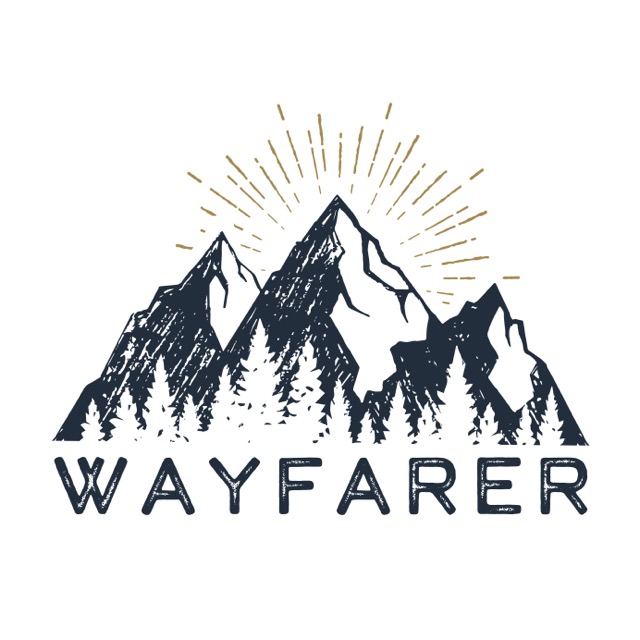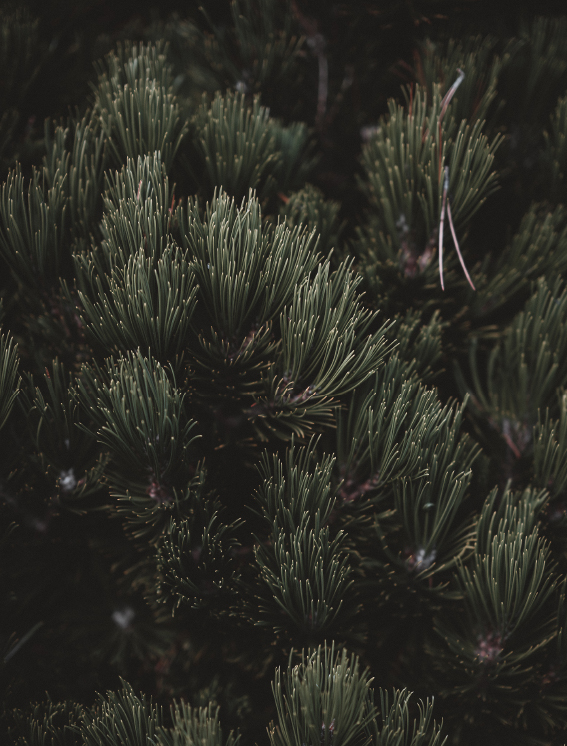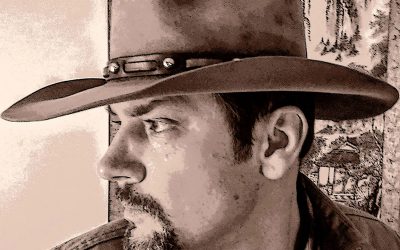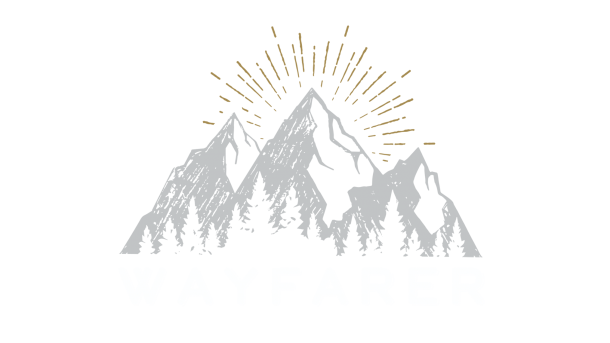June 27, 2019
Three nights in a row coyotes wake me. In our tent, the thin membrane that allegedly protects us from the wild outside, my wife and daughter and three rescue dogs slept through the howls. Several times I fell back to sleep, briefly, only to rise with heart pounding to their wild calls. They ran and sang at least a mile away, carried on the cool night air, moving counter-clockwise around us.Three nights in a row coyotes wake me. In our tent, the thin membrane that allegedly protects us from the wild outside, my wife and daughter and three rescue dogs slept through the howls. Several times I fell back to sleep, briefly, only to rise with heart pounding to their wild calls. They ran and sang at least a mile away, carried on the cool night air, moving counter-clockwise around us.Once, half-awake, at the edge of a dream, I thought they were calling to me. Perhaps they were. Only they know.Now I hang in a hammock between two piñon pines, a light breeze moving over me, fine morning hike behind our crew. I scribble in my journal. There’s something about a hammock after a good, long walk—life elevated, but not in the sense of a silly hashtag. A respite well earned, with a view.Our Forest Service campground soothes, relatively silent. Of the fifteen sites in our circle, only three are occupied. The quiet would be a bit more comforting without my 5 ½-year old daughter playing with her dolls and body-slamming the hammock every once in a while, still full of energy even after a 5-mile hike above 9,000’. But this is her wild place, too. It’s a tried-but-truism to say we protect these open spaces for coming generations, a sentiment I like except that it ignores the obvious reality that there are other beings here, as well, just beginning their feral life journeys. Some we see, most we don’t. This space might be our playground, but it’s their home. Last night as the sun’s rays ebbed, while my daughter and I watched Venus emerge, leading the star parade in our expansive Nevada sky, the coyotes again set up a howl. They started to the northeast and southwest of us, carrying on all night, voices drawing a circle around our human enclave, cries of joy and maybe defiance. Dangerous as it is to anthropomorphize, I always hear coyotes’ whooping howls as an act of insubordination to human development, human ambitions. A kind of feral, We’re still here. I slept fitfully but well as they broke my sleep with their calls for another night.Truth is, they wake something deeper inside me.I’m out here with family to enjoy our public lands. I find it pointless to work to defend something and not spend time there—I’m no armchair social media slacktivist. I stand for what I stand on, as some say. I’m out on the land as much as possible. In the summertime that means heading for the hills and woods to get away from southern Nevada’s broiling heat. On our walk in the dry, pine-laden morning air, we caught the view from a ridge approaching Ward Mountain: to the west the landscape was occluded by smoke from California’s wildfires. A fifty-mile vista hidden in haze. Our current Secretary of the Interior blames these fires on “extreme environmentalists” (Canon). I would laugh if the rhetoric weren’t so precarious: like coyotes, those of us who speak up for the land are being singled out as dangerous. All around the American West our National Forests burned well past when they normally do, and the only climate not changing is the one in Washington, DC. In this challenging political moment and assault on our treasured public lands, I think we could all take a cue from the coyote: make our voices heard for these landscapes we love and use. Be wild. Be loud. Be proud. If loving the land is considered extreme, then be extreme: let voices of joy flood the offices of those suit-bound politicians who spend too much time in air conditioning. But we need to get out on the land, too. Remember what connects us. Wild Nevada calls me, and whenever I can I answer. I live in the desert but I’m addicted to mountains. Some ranges in Nevada house the oldest living things on the planet: bristlecone pines, gnarled, twisted beings that can live over 3,000 years. They’ve lived through changes before, but what’s coming might be different. Time will tell. In Nevada’s forests the air gets so dry you can smell the pine like it’s an aroma in your home. I rub my fingers on a piñon’s needles and let the smell play through my sinuses.
Wildness.
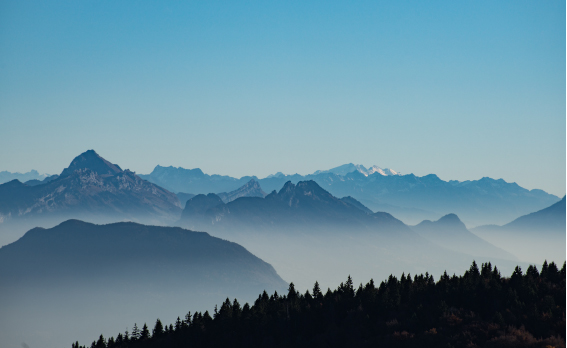
Though some areas are closed for military purposes, most of the rest of my state is open public land, with almost 3.5 million acres of Congressionally-protected capital W Wilderness—which means that it is open for you, dear reader, to explore. Many of the wilderness areas and National Forest campsites are free. Many Americans don’t even know these areas exist and, better yet, that they own them. They’re yours, ours—part of the public trust, one of the best things about being an American. I remember the words of the rapper DMX when he saw Yellowstone National Park for the first time: “I had no idea any of this was even here.”Well, it is, and I’m lucky to live close enough to be able to enjoy our public lands as often as my schedule allows. But the rapacious forces of greed and power can never seem to get enough to satisfy them. Two of our Nevada—“our” as in We the People’s—National Monuments may be scaled back from current protections, not to mention what’s happening to Bear Ears and Grand Staircase-Escalante in Utah next door. An entrenched resentment exists in some Americans who already have and own too much over the word “public,” as if it’s anti-American—and that those spaces designated “public” should by necessity and tradition be privatized. Many of us Westerners know too well what happens when private interests take over public lands, especially in dry climates like the southwest: roads, clearcuts, cryptogamic soil disruption, oil and natural gas development, mining—scars in desert ecosystems that can take a hundred years or more to heal.No, thanks. I’ll keep my open space public, please—for all of us, human and not. So far as forest policy goes, the economic arguments of the past don’t make sense any longer. In 2016, for example, the outdoor recreation industry “made up 2 percent of the national GDP—more than mining, oil and gas extraction combined.” Here in my own state of Nevada, outdoor recreation generates 87,000 jobs, a $12.6 billion economy in its own right, with some of that feeding into state and local tax coffers. That’s three times more jobs than created by the mining industry here. And perhaps more importantly, those jobs are sustainable, so long as we have healthy landscapes—potentially forever.But far more important than economics, the restorative effects of time in wilderness reenlivens, reenergizes—good and necessary things in a world whose politics seem to wear those of us who care about the health of the land down to the bone. I need this break to hike and hang in my hammock because when I get home, like many of us it’ll be time to get back on the phone and email and work to keep these spaces wild and free and open. On our beautiful, lessening blue/green planet, we lose an area of forest the size of a football field every second, an annual total the size of Italy. Deforestation may increase now that Brazil has a President who says development of the Amazon will be a primary goal of his administration. The Amazon acts literally as the lungs of our planet. Worldwide, our leaders can’t seem to see the forests for the trees they allow to be sacrificed for their vision of progress. And with a future planetary human population potentially pushing 9 billion or more, who knows what environmental issues loom before us.One thing seems pretty obvious: we should keep our remaining forests wild and undeveloped, from Alaska’s Tongass to Maine’s White Mountain to my own Toiyabe here in the heart of Wild Nevada. As Americans, we can use our voices to keep them protected and wild. I think future generations will thank us.This morning we walked through a healthy mix of piñon, juniper, ponderosa pine, with lots of ground cover plants, birdsong, and signs of plenty of fauna. The day before we walked under a pair of circling ravens and peregrines, turning on thermals, on the hunt. Not a climax ecosystem, but a reasonably healthy mix of biodiversity. And there’s so much more that we can’t see. In his astonishing book The Hidden Life of Trees, Peter Wohlleben stresses time and again how “people rely heavily on sight, and so we are particularly influenced by this sense….The diversity of animal life plays out mostly in the microscopic realm, hidden from the eyes of forest visitors.” We have four days here, so we slow down, settle in, begin to notice what’s around us. We need stillness and silence to learn to see and hear with the eyes of a forest—time, deep time. Capitalist macroeconomics has little patience for such pastimes. Still, I try to impress this in my daughter: wilderness allows life here to thrive, all the diverse beings we see and hear, without much more human development than some campsites and a water tank. Wildness and biodiversity thrive in a vigorous ecology where fearless voices cry out. Silence implies consent. In order to keep what wild remains intact, let’s not be afraid to be like the coyote and make joyous calls of our own to any that can hear—to howl with both rage and ecstasy, let them know we’re still here.
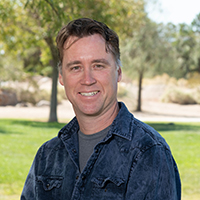
William Huggins
Writer
William Huggins was born in the wild red rock beauty of southeastern Utah. He now lives, writes, works, and explores the desert southwest with his wife, daughter, and three rescue dogs. His father’s work for the United States Air Force caused the family to move a lot, usually to remote areas, and from an early age he learned to love to explore wild places.
A compulsive reader from an early age, he studied English at the University of South Dakota, Vermillion and later garnered a Masters in Arts in Literature, with an emphasis on environmental and indigenous literatures, from the University of Nevada, Las Vegas. Ecological issues suffuse his short science fiction, which can be found in Third Flatiron Anthologies, Another Realm, Expanded Horizons, and Universe VII: Visions, from Lillicat Publishers, among other places.
His critical essays have appeared in various media, including Studies in American Indian Literature, Southwestern American Literature, Texas Books in Review, The Canadian Review of Comparative Literature, The Journal for Critical Animal Studies, and Critical Insights: Louise Erdrich. He has several essays coming out in books in the near future.
He also blogs for several websites on various green issues, most often We Are Wildness but also environmental organizations.
Related Articles
12 Tiny Things, Two Open Hearts
Meet 12 Tiny Things authors Heidi Barr & Ellie Roscher, interviewed by Wayfarer Editor Leslie M. Browning | From the Spring 2021 Issue
Our Angel of the Get Through | An Interview with Andrea Gibson
From our Autumn 2019 Edition | Visit our store to treat yourself to the full issue in either print or digital format. | Browse the Store› The Wayfarer of our Autumn 2019 Issue | Shop Now All Rights Reserved. Our Angel of the Get Through A Conversation...
East Meets Southwest | A Conversation with Poet Frank LaRue Owen
From our Spring 2019 Edition | Visit our store to treat yourself to the full issue in either print or digital format. | Browse the Store› The Wayfarer of our Spring 2019 Issue There are certain path crossings that stay with you as fated moments—certain...
Stay Up to Date With The Latest News & Updates
Subscribe
We offer our biannual issues in both print and digital editions.
Explore. Replenish. Inspire.
Join Our Newsletter
The Wayfarer posts new content weekly and releases two print issues a year on the first of Autumn and Spring, respectively. Sign up for our free monthly digest of the month’s most inspiring articles across nature, poetry, personal essay, and more as we continue on our mission to foster a community of contemplative voices and provide readers with resources and perspectives that support them in their own journey. Sign Up Below:
Follow Us
Join us in our digital communities.
learn more
Write Us
Get IN touch
(860).574.5847
The Wayfarer Magazine
PO Box 1442, Pawcatuck CT 06379-1442
With Basecamps in:
- Mystic, Connecticut
- Las Vegas, Nevada
- Cambridge, Massachusetts
